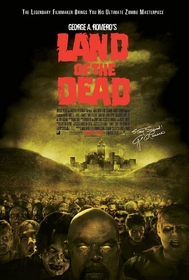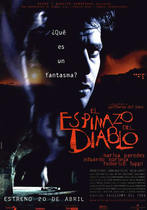Our editor-in-chief Nate Yapp is proud to have contributed to the new book Hidden Horror: A Celebration of 101 Underrated and Overlooked Fright Flicks, edited by Aaron Christensen. Another contributors include Anthony Timpone, B.J. Colangelo, Dave Alexander, Classic-Horror.com's own Robert C. Ring and John W. Bowen. Pick up a copy today from Amazon.com!
Land of the Dead (2005)
I'm not a huge rap fan, but the latest slew of zombie flicks (Resident Evil, House of the Dead, the Dawn of the Dead remake) kind of reminds me of that Dr. Dre song "Forgot About Dre." With all the undead brouhaha, seems like Hollywood forgot about the progenitor of the modern zombie film - George A. Romero.
Well, now he's back with a brand-new film in the Dead series, Land of the Dead. The good news: it's a welcome addition to the genre, especially in an era where American horror has become so watered down and unexciting. The less-good news: it's not as successful as I'd hoped.
At an indeterminate time after Night of the Living Dead, humanity is woefully outnumbered. One major city has locked itself off from the outside, setting up a dichotomous society - the haves live in a gleaming citadel of glass and steel called Fiddler's Green, while the have-nots scrape by on the streets, giving in to the vices that the upper class set up to distract them. Supplying the city is a band of mercenaries led by Riley (Simon Baker). They drive through the zombie-infested outer regions in a gigantic armored vehicle, scouring for food, medicine, and other essential supplies. Of course, they also take a little time for mowing down the walking dead, who don't exactly take kindly to being terminated.
From a horror standpoint, Romero still has it. The film is tightly paced with very few moments of lag. He uses a lot of jump scares this time out, in contrast to the "they're coming to get you, Barbara" style of inevitable terror used in the previous three Dead films. There is one beautiful, tricky sequence where he plays with the audience's expectations, by leaving out a scare where there should be one by all rights. With other directors, this might seem like a cop-out, but under Romero's masterful guidance, it actually amps up the suspense.
Satire, Romero's constant companion, is as evident in Land as it is in the previous three films. Here he tackles the American Dream. The people in Fiddler's Green have it. The people on the streets want it. However, like any dream, it's not real. One resounding wake-up call and it all comes crashing down.

Zombies belong where they can shamble, people belong where they can die...
This wake-up call comes because the zombies, on some level, also want the American Dream: a place of their own, a sense of safety, and a large intestine in the pot. Romero begins to build the zombies as more complex beings, utilizing limited cognition and communication. Lead by Big Daddy (Eugene Clark), they begin to mass as a concentrated force, looking for their own piece of the sky.
Unfortunately, the concept of the evolved zombie ends up being one of the failings of the film. No longer a simple force of nature, a damning consequence of human mishap, they lose some of their power. When Big Daddy figures out how to use weaponry, it's not exactly terrifying. I wanted to pat him on the head and give him a cookie. It's not so much their intelligence that I take issue with, but the emotion that comes with it. They're acting on more complex motives, and it's difficult to tap into that for primal fear.
I found Fiddler's Green, an integral part of the theme, to be muddled. A good chunk of the characters jabber about its opulence and desirability, but what little we see of its insides during a calm time (during a television commercial that mocks the have-nots more than it actually advertises) isn't that enticing. It looks like a gigantic shopping mall. The one residence in evidence belongs to the most powerful man in the city, which probably means it's the exception rather than the rule. I wanted to see the real appeal, other than just being a clean place to live.
KNB EFX's make-up work is... amazing. If you're into gore effects, you'll be amazed at how much Romero managed to sneak past the MPAA and still get an 'R' rating. Zombie heads get stomped, torsos get ripped open, necks and limbs are bitten. A couple really gruesome zombies explore how much damage the walking dead can take before they, um, cease mobility.
Unlike Day of the Dead, Land of the Dead doesn't suffer from weak performances. Dennis Hopper may be a little off-kilter, but otherwise, this is a solid, professional cast. John Leguizamo brings his own chutzpah to the requisite loose cannon, Cholo. In the lead, Baker performs his part with a quiet intelligence. In any other entry in the series, he'd be the heart of the film, but the script doesn't allow any of these performances to breathe.
Simply put, George Romero lets the ideas overtake the characters in this go-round. While there's certainly a greater number of sympathetic figures here than in any of his previous Dead films, none of them have the kind of strong identification that has been the hallmark of the series.
I acknowledge that, perhaps, I'm being unfair to the film. It shouldn't be judged on the merits of Romero's previous films, merely on its own. However, I feel that there's a certain expectation that Romero sets up for a well-crafted human drama that involves zombies. Too often, Land of the Dead is just an action-horror flick with some big ideas. It's still a great ride on a lot of levels, but it will never top Night of the Living Dead or Dawn of the Dead. Perhaps that's just as well, too.
Trivia:
Tom Savini's appearance marks
the first time the same character has appeared in two Dead films.
Simon Pegg and Edgar Wright, respectively the star and the director of Shaun of the
Dead, make cameos as zombies.








